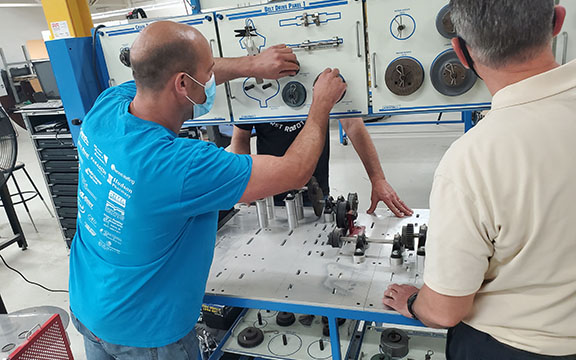Our series on apprenticeships for Economic Development Week highlights the correlation between business, education, jobs, and the economy. All of these contribute to a healthy economy, which we are dedicated to strengthening through the attraction and retention of local businesses, enriching our local workforce, and promoting the area’s amenities. This week, we are focusing on apprenticeships to highlight an amazing career opportunity at companies that are right here in Lenawee County.
What Is an Apprenticeship?
Students getting ready to graduate high school have numerous possibilities before them and an abundance of choices, making it difficult to know where to start. College or trade school? School or work? Stay home or move away? It can be overwhelming.
One of the options graduating students can choose is an apprenticeship. This word may have been pigeonholed to a certain type of job or industry, but in reality, apprenticeships are available in a wide range of professions.
An apprenticeship is paid employment where workers train on the job while also taking courses to learn more about the said position. An apprenticeship can last between one to four years, with some taking a matter of months and others lasting as many as six years. Workers are paid at least minimum wage (often more) and work an average of 30 hours a week.
Becoming an apprentice requires time management, self-motivation, and organization. A combination of hands-on work with classroom training gives the student immediate real-life application. Apprenticeships allow students to become holistically educated in a particular line of work rather than learning first, then doing.
Trades may be the first career category thought of when considering an apprenticeship, but there are many more. The top five industries for apprenticeships include:
- Business, Administrative & Law
- Paralegal, human resources manager, insurance, banking, and assistant/secretary.
- Health, Public Service Care
- Dental assistant, paramedic, certified nurse’s aide, and pharmacist assistant.
- Retail and Commercial
- Barber, beautician, and hairdresser.
- Engineering and Manufacturing
- Electrician, HVAC, and Tool & Die.
- Construction, Planning & the Built Environment
- Construction, plumbing, and surveying.
As of 2020, there are 26,000 active apprenticeship programs in the United States according to the U.S. Department of Labor. That same year 221,000 individuals entered the apprenticeship system and 82,000 graduated. In Michigan, there were 1,085 active programs in 2020, 5,834 individuals who entered the apprenticeship system, and 2,128 graduates.
A considerable advantage that apprenticeships have over traditional schooling is learning while getting paid. Although apprentices have to work up to 30 hours a week, they are also getting paid for their time in the classroom. This can help pay for schooling and/or housing, leaving little to no debt after graduation. As the apprentice moves through their training, their pay may increase as well.
Colleges and trade schools often offer credit for apprenticeship programs. This means a student can graduate with a degree and have a certificate stating they are specialized in a certain area of their profession.
Students who are considering this path can find an apprenticeship in several ways. Nationally apprenticeships can be found through the U.S. Department of Labor at www.apprenticeship.gov. In Michigan, MIApprenticeship is a program through the State of Michigan helping both career seekers and employers. Local Michigan Works! Offices can also help individuals looking to enter an apprenticeship.
The results speak for themselves. According to the United States Department of Labor, 94 percent of apprentices retain employment after completion, meaning apprentices have a job immediately. These jobs also pay very well, with an average salary of $70,000 a year.
While apprenticeships may not be the first thing that students think about when they consider their life after school, the benefits truly outweigh the costs for students that are looking to earn while they learn.

